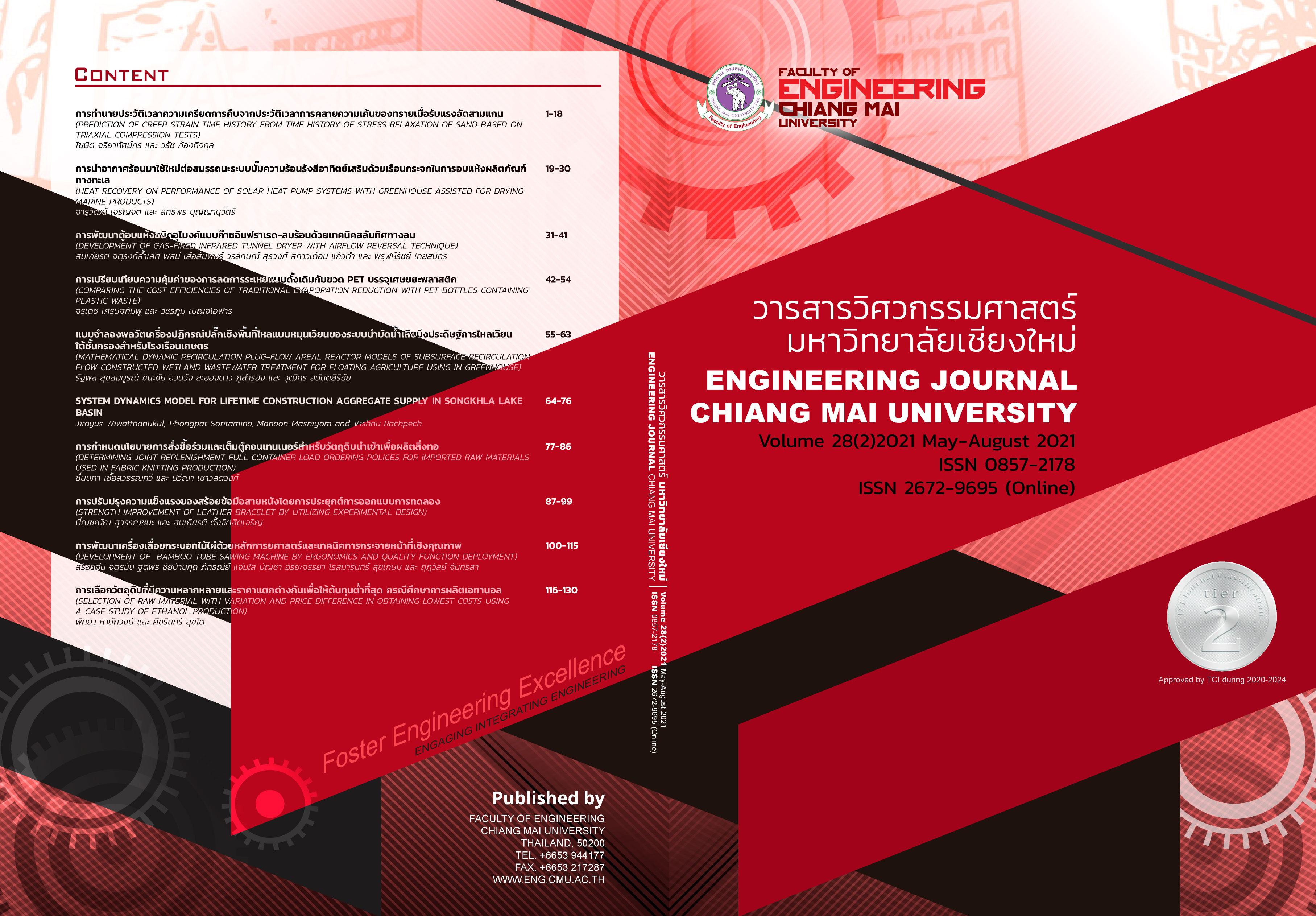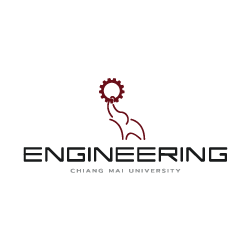Development of Bamboo Tube Sawing Machine by Applying Ergonomics Principles and QFD
Keywords:
Bamboo sawing machine, Khao lam, Product development, Ergonomics, Quality function deploymentAbstract
The objective of this research is to design and develop a bamboo tube sawing machine used for baked sticky rice (Khoa Lam) according to ergonomic principles by applying the Quality Function Deployment technique (QFD). After studying the current machine used in the case study enterprise, many problems were found such as low operation efficiency, and poor machine design in terms of ergonomics and safety. Thus, this research employed RULA technique in order to assess the risks of postures that an operator performed when using the current machine. The RULA assessment indicated the risk level score at 6, which means that ergonomics problems were occurred. The research then applied QFD to collect user needs for the machine and translate these needs into the technical specifications of the machine. The results of QFD showed that the top three priorities of the technical specifications were having safety equipment, appropriate sound pressure level, and lower dust production. The 3 initial concepts of machine were then designed and evaluated to select the most appropriate one using factors rating method. The most preferred concept was then designed in detail by taking ergonomics into account. After that, the prototype of the new machine was constructed before testing and evaluating the results. Efficiency testing showed that the new machine had a sawing rate of 5 tubes per minute or 25 percent increasing from the current machine. The risk score of working postures was decreased to 4, or risk level of 2 when evaluating by RULA technique. User satisfaction assessment score was 4.46 out of 5, which was almost the highest level.
References
[2] Cohen L. (1995). Quality function deployment how to make QFD work for you, Addison-Wesley, Massachusetts.
[3] McAtamney, L. and Nigel Corlett, E. (1993). RULA: a survey method for the investigation of work-related upper limb disorders, Applied Ergonomics, Vol. 24(2), pp. 91-99.
[4] Ulrich, K.T. and Eppinger, S.D. (2012). Product design and development, 5th edition, McGraw-Hill, New York.
[5] Dieter, G.E. and Schmidt, Linda C. (2013). Engineering Design, 5th edition, McGraw-Hill, Singapore.
[6] มณฑลี ศาสนนันทน์ (2550), การออกแบบผลิตภัณฑ์เพื่อการสร้างสรรค์นวัตกรรมและวิศวกรรมย้อนรอย, พิมพ์ครั้งที่ 2, สำนักพิมพ์มหาวิทยาลัยธรรมศาสตร์, กรุงเทพฯ.
[7] เกียรติวิทย์ สมทอง และ นลิน เพียรทอง (2559). การพัฒนาผลิตภัณฑ์กุนเชียงด้วยเทคนิคการกระจายหน้าที่เชิงคุณภาพ, วารสารข่ายงานวิศวกรรมอุตสาหการไทย, ปีที่ 2, ฉบับที่ 1, มกราคม-มีนาคม 2559, หน้า 19-26.
[8] สุรสิทธิ์ ระวังวงศ์, ชาตรี หอมเขียว, วรพงค์ บุญช่วยแทน, จักรนรินทร์ ฉัตรทอง และ มูหามัด เต๊ะยอ (2563). การประยุกต์ใช้เทคนิคการแปลงหน้าที่เชิงคุณภาพในการพัฒนาผลิตภัณฑ์เครื่องปั้นดินเผา กรณีศึกษา วิสาหกิจชุมชนเครื่องปั้นดินเผาในจังหวัดนครศรีธรรมราช, วารสารมหาวิทยาลัยนราธิวาสราชนครินทร์, ปีที่ 12 ฉบับที่ 1 มกราคม-เมษายน 2563, หน้า 106-119.
[9] Phontri, C. and Chantrasa, R. (2019). Innovation development of durian stick processing machine for transferring knowledge to foundation community, Asia-Pacific Journal of Science and Technology, vol.24 (4), October-December 2019, pp. 1-10.
[10] Mat, Kudus, S.K.A. and Keith Case, K. (2019). Application of Quality Function Deployment in Product Design and Development: Car Seat Case Study, Proceedings of the 6th International Conference and Exhibition on Sustainable Energy and Advanced Materials (ICE-SEAM 2019), 16-17 October 2019, Surakarta, Indonesia.
[11] อรณิชา ยมเกิด, ปิยะวัฒน์ ตรีวิทยา และ นิวิท เจริญใจ (2015). การปรับปรุงท่าทางการนั่งทำงานของพนักงานในอุตสาหกรรมตีมุดด้วยหลักการยศาสตร์, วารสารวิศวกรรมศาสตร์ มหาวิทยาลัยเชียงใหม่, 22(3), หน้า 10-20.
[12] วีรชัย มัฎฐารักษ์, เดช เหมือนขาว และ ยงยุทธ ดุลยกุล (2555). การศึกษาทางการยศาสตร์เพื่อปรับปรุงการทำงานในกระบวนการผลิตน้ำตาลโตนด กรณีศึกษา : กลุ่มแม่บ้านตำบลสนามชัย อำเภอสทิงพระ จังหวัดสงขลา, วารสารวิศวกรรมศาสตร์ ราชมงคลธัญบุรี, ปีที่ 10, ฉบับที่ 1, มกราคม-มิถุนายน 2555, หน้า 49-58.
[13] องุ่น สังขพงศ์, กลางเดือน โพชนา และ วรพล เอื้อสุจริตวงศ์ (2556). การปรับปรุงสถานีงานตามหลักการยศาสตร์เพื่อลดความเสี่ยงที่ก่อให้เกิดความเมื่อยล้ากล้ามเนื้อของแรงงานในกระบวนการผลิตปลาทูน่า: กรณีศึกษาโรงงานแปรรูปอาหารทะเลแห่งหนึ่ง, วารสารวิชาการพระจอมเกล้าพระนครเหนือ, ปีที่ 23 ฉบับที่ 3, กันยายน-ธันวาคม 2556, หน้า 654-663.
[14] Robielos, R.A.C., Sambua, K.C.A. and Fernandez, J.G. (2019). Ergonomics Intervention for Healthcare Workers and Patients: A Development of Patient Handling Device, Advances in Intelligent Systems and Computing, 820, pp. 615-638.
Downloads
Published
Issue
Section
License
ลิขสิทธิ์ของบทความที่ตีพิมพ์ในวารสารฉบับนี้จะยังเป็นของผู้แต่งและยินยอมให้สิทธิ์เผยแพร่กับทางวารสาร
การเผยแพร่ในระบบวารสารแบบเปิดนี้ บทความจะสามารถนำไปใช้ได้ฟรีในการศึกษา และในทางที่ไม่เกี่ยวกับการค้า




